ECU MITSUBISHI LANCER 2014 8.G Owners Manual
[x] Cancel search | Manufacturer: MITSUBISHI, Model Year: 2014, Model line: LANCER, Model: MITSUBISHI LANCER 2014 8.GPages: 434, PDF Size: 57.5 MB
Page 11 of 434
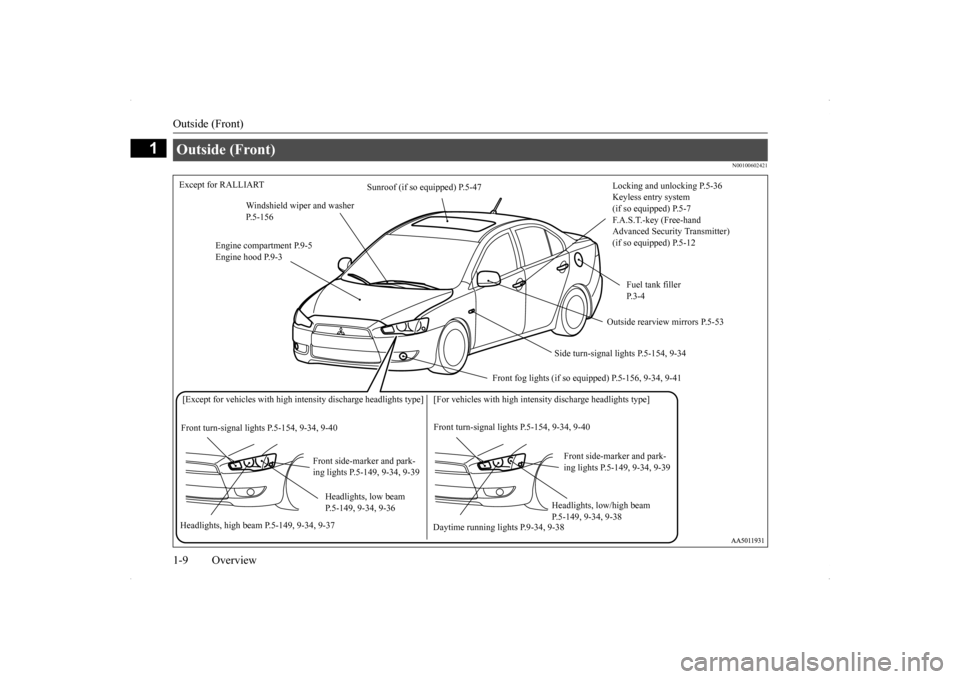
Outside (Front) 1-9 Overview
1
N00100602421
Outside (Front)
Locking and unlocking P.5-36 Keyless entry system (if so equipped) P.5-7 F.A.S.T.-key (Free-hand Advanced Security Transmitter) (if so equipped) P.5-12
Except for RALLIART
Sunroof (if so equipped) P.5-47
Windshield wiper and washer P.5-156
Engine compartment P.9-5 Engine hood P.9-3
Fuel tank filler P.3-4
Outside rearview mirrors P.5-53
Side turn-signal lights P.5-154, 9-34
Front fog lights (if so eq
uipped) P.5-156, 9-34, 9-41
[Except for vehicles with high intensity
discharge headlights type] [For vehicles with
high intensity discharge headlights type]
Front turn-signal light
s P.5-154, 9-34, 9-40
Front turn-signal light
s P.5-154, 9-34, 9-40
Front side-marker and park- ing lights P.5-149, 9-34, 9-39
Front side-marker and park- ing lights P.5-149, 9-34, 9-39
Headlights, low beam P.5-149, 9-34, 9-36
Headlights, low/high beam P.5-149, 9-34, 9-38
Headlights, high beam P.5-149, 9-34, 9-37
Daytime running li
ghts P.9-34, 9-38
Page 12 of 434
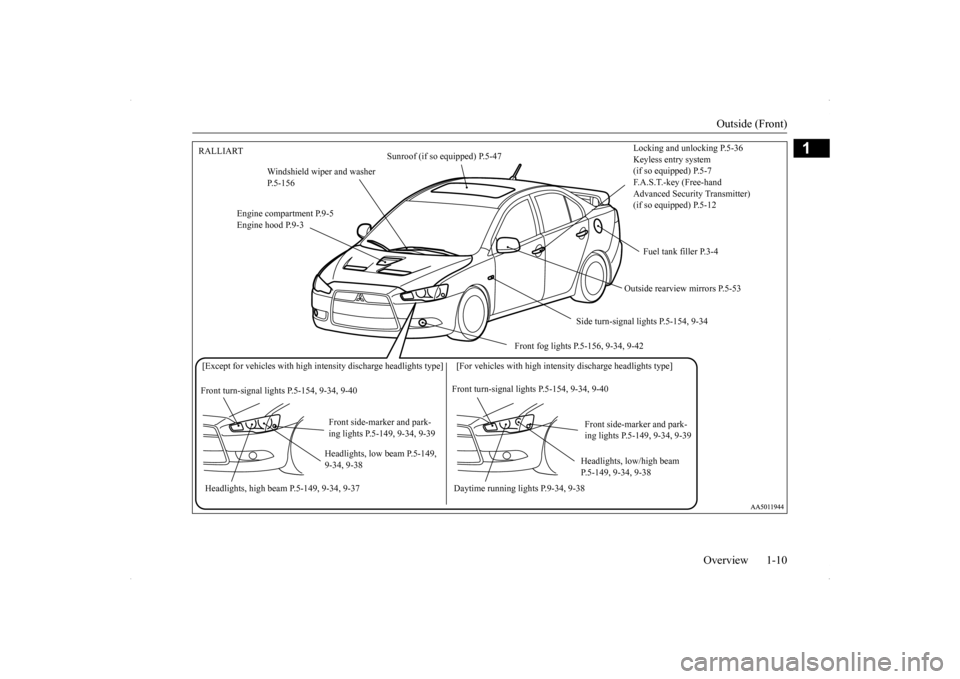
Outside (Front)
Overview 1-10
1
Locking and unlocking P.5-36 Keyless entry system(if so equipped) P.5-7 F.A.S.T.-key (Free-hand Advanced Security Transmitter)(if so equipped) P.5-12
RALLIART
Sunroof (if so equipped) P.5-47
Windshield wiper and washer P.5-156
Engine compartment P.9-5 Engine hood P.9-3
Fuel tank filler P.3-4
Outside rearview mirrors P.5-53
Side turn-signal lights P.5-154, 9-34
Front fog lights P.5-156, 9-34, 9-42
[Except for vehicles with high intensity di
scharge headlights type] [For
vehicles with high intensity discharge headlights type]
Front turn-signal light
s P.5-154, 9-34, 9-40
Front turn-signal light
s P.5-154, 9-34, 9-40
Front side-marker and park- ing lights P.5-149, 9-34, 9-39
Front side-marker and park- ing lights P.5-149, 9-34, 9-39
Headlights, low beam P.5-149, 9-34, 9-38
Headlights, low/high beam P.5-149, 9-34, 9-38
Headlights, high beam P.5-149, 9-34,
9-37 Daytime running lights P.9-34, 9-38
Page 26 of 434

Modifications to and racing of your vehicle
General information 3-5
3
4. While filling with fuel, store the cap in the cap holder located on the inside of the fuel tank filler door. 5. To fill with fuel correctly depends mainly on correct handling of the fuel filler noz- zle. Do not tilt the nozzle. Insert the noz-zle in the tank port as far as it will go.
6. When the nozzle stops automatically, do not attempt to add more fuel. 7. To close, turn the fuel tank filler cap slowly clockwise until you hear clickingsounds, then gently push the fuel tank filler door closed.
N00301600048
This vehicle should not be modified withnon-Mitsubishi Motors genuine parts. Mit- subishi Motors designs and manufactureshigh quality vehicles
with an emphasis on
safety and durability. Modifications using non-Mitsubishi Motors genuine parts mayaffect the performance, safety and/or durabil- ity of your vehicle, and may violate applica- ble state and/or federal regulations. DAMAGE OR PERFORMANCE PROB- LEMS RESULTING FROM MODIFICA- TIONS TO OR RACING OF YOUR
CAUTION Your vehicle can only be operated using unleaded gasoline. Serious engine and cata-lytic converter damage will result if leaded gasoline is used.
CAUTION To avoid fuel spillage and overfilling, do not “top-off” the fuel tank. Spilled fuel coulddiscolor, stain, or crack the vehicle’s paint- work. If fuel spills on the paintwork, wipe it off with a soft cloth.WA R N I N G Make sure the fuel cap is securely closed. If the fuel cap is loose, fuel could leak, resulting in a fire.CAUTION If you need to replace the fuel tank filler cap, use only the cap specified for your model vehicle.
NOTE
If the fuel tank filler
cap is not tight while
driving, the engine malfunction indicator (“SERVICE ENGINE SOON” or “Check engine light”) may come on when the onboard diagnostic (OBD) system performsa self check. Always tighten the fuel tank filler cap until you hear clicking sounds.The indicator will go off after driving several times. If the indicator does not go off, con- tact your authorized Mitsubishi Motorsdealer or a repair facility of your choice as soon as possible.
Modifications to and racing of your vehicle
Page 31 of 434
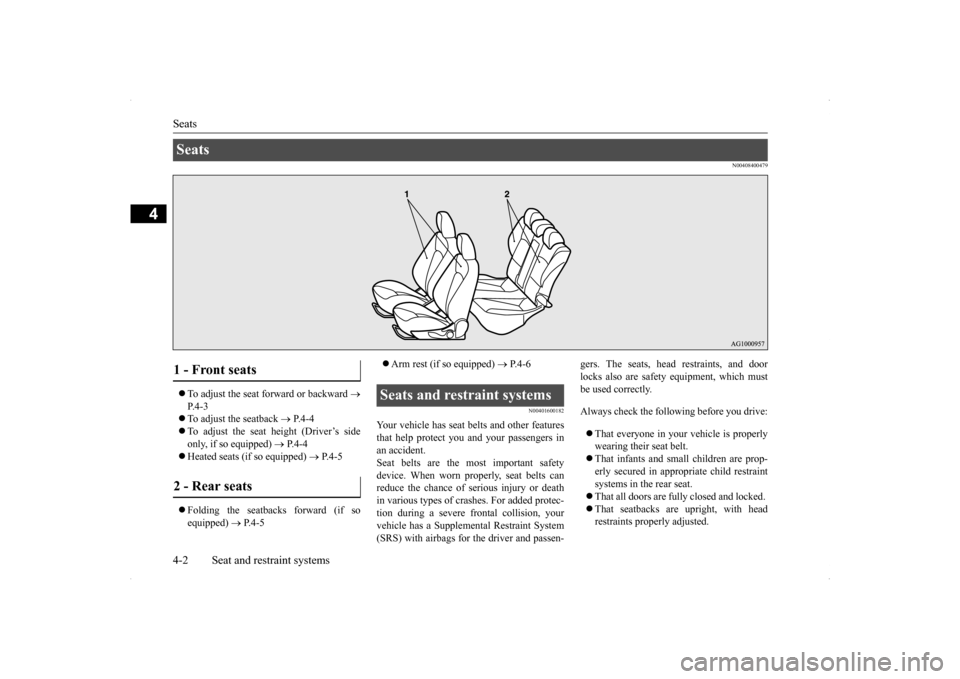
Seats 4-2 Seat and restraint systems
4
N00408400479
To adjust the seat forward or backward
P.4-3 To adjust the seatback
P.4-4
To adjust the seat height (Driver’s side only, if so equipped)
P.4-4
Heated seats (if so equipped)
P.4-5
Folding the seatbacks forward (if so equipped)
P.4-5
Arm rest (if so equipped)
P.4-6
N00401600182
Your vehicle has seat belts and other features that help protect you and your passengers in an accident. Seat belts are the most important safetydevice. When worn properly, seat belts can reduce the chance of serious injury or death in various types of crashes. For added protec-tion during a severe frontal collision, your vehicle has a Supplemental Restraint System (SRS) with airbags for the driver and passen-
gers. The seats, head restraints, and door locks also are safety equipment, which must be used correctly. Always check the following before you drive: That everyone in your vehicle is properly wearing their seat belt. That infants and small children are prop- erly secured in appropriate child restraintsystems in the rear seat. That all doors are full
y closed and locked.
That seatbacks are upright, with head restraints properly adjusted.
Seats 1 - Front seats 2 - Rear seats
Seats and restraint systems
Page 32 of 434
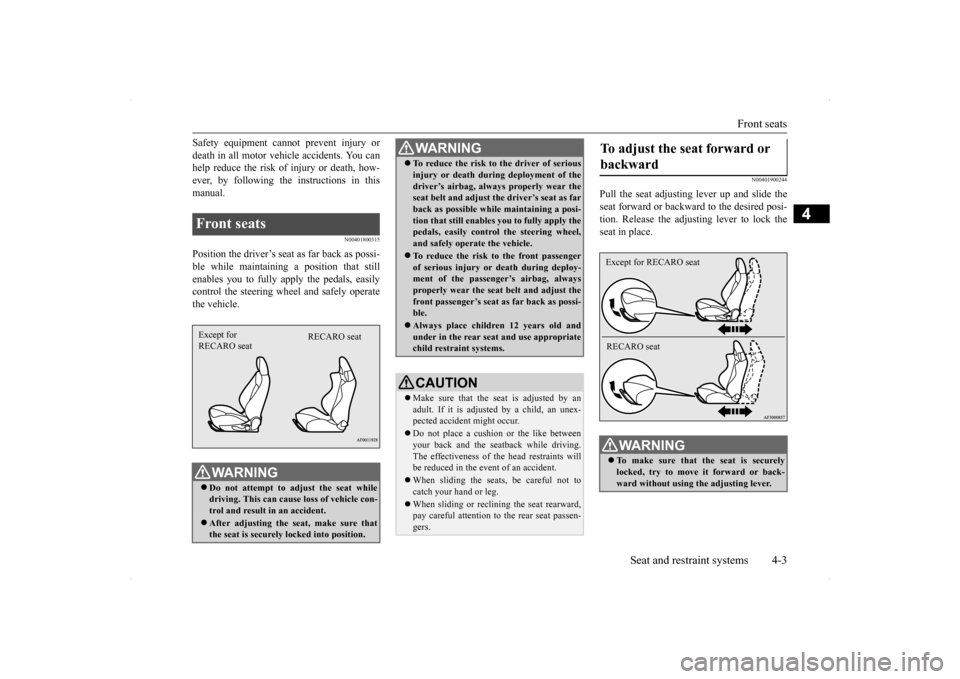
Front seats
Seat and restraint systems 4-3
4
Safety equipment cannot prevent injury or death in all motor vehicle accidents. You can help reduce the risk of injury or death, how- ever, by following the
instructions in this
manual.
N00401800315
Position the driver’s seat
as far back as possi-
ble while maintaining a position that stillenables you to fully apply the pedals, easily control the steering wheel and safely operate the vehicle.
N00401900244
Pull the seat adjusting lever up and slide theseat forward or backward to the desired posi- tion. Release the adjusting lever to lock the seat in place.
Front seats
WA R N I N G Do not attempt to adjust the seat while driving. This can cause loss of vehicle con-trol and result in an accident. After adjusting the seat, make sure that the seat is securely locked into position.Except for RECARO seat
RECARO seat
To reduce the risk to the driver of serious injury or death during deployment of the driver’s airbag, always properly wear the seat belt and adjust th
e driver’s seat as far
back as possible while maintaining a posi-tion that still enables
you to fully apply the
pedals, easily control the steering wheel, and safely operate the vehicle. To reduce the risk to the front passenger of serious injury or death during deploy-ment of the passenger’s airbag, always properly wear the seat belt and adjust the front passenger’s seat as far back as possi-ble. Always place children 12 years old and under in the rear seat and use appropriate child restraint systems.CAUTION Make sure that the seat is adjusted by an adult. If it is adjusted by a child, an unex-pected accident might occur. Do not place a cushion or the like between your back and the seatback while driving. The effectiveness of the head restraints will be reduced in the event of an accident. When sliding the seats, be careful not to catch your hand or leg. When sliding or reclining the seat rearward, pay careful attention to the rear seat passen- gers.WA R N I N G
To adjust the seat forward or backward
WA R N I N G To make sure that the seat is securely locked, try to move it forward or back- ward without using the adjusting lever. Except for RECARO seat RECARO seat
Page 34 of 434
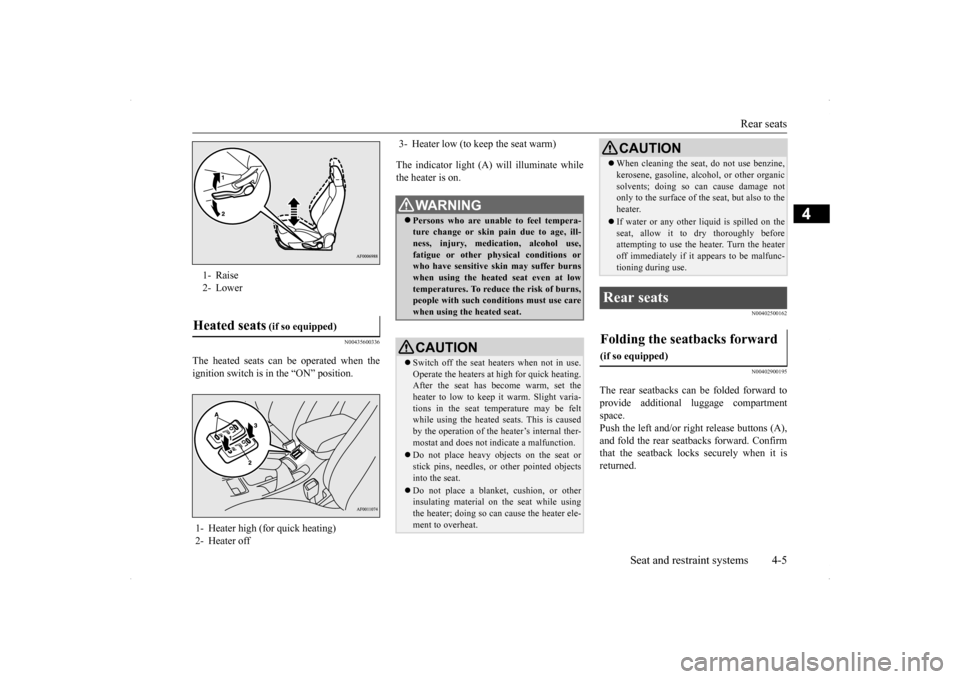
Rear seats
Seat and restraint systems 4-5
4
N00435600336
The heated seats can be operated when the ignition switch is in the “ON” position.
The indicator light (A) will illuminate while the heater is on.
N00402500162 N00402900195
The rear seatbacks can be folded forward to provide additional luggage compartment space.Push the left and/or right release buttons (A), and fold the rear seatbacks forward. Confirm that the seatback locks securely when it isreturned.
1- Raise 2- Lower Heated seats
(if so equipped)
1- Heater high (for quick heating) 2- Heater off
3- Heater low (to keep the seat warm)
WA R N I N G Persons who are unable to feel tempera- ture change or skin pain due to age, ill- ness, injury, medication, alcohol use,fatigue or other physical conditions or who have sensitive skin may suffer burns when using the heated seat even at lowtemperatures. To reduce the risk of burns, people with such conditions must use care when using the heated seat.CAUTION Switch off the seat heaters when not in use. Operate the heaters at high for quick heating. After the seat has become warm, set theheater to low to keep it warm. Slight varia- tions in the seat temperature may be felt while using the heated seats. This is causedby the operation of the heater’s internal ther- mostat and does not indicate a malfunction. Do not place heavy objects on the seat or stick pins, needles, or other pointed objectsinto the seat. Do not place a blanket,
cushion, or other
insulating material on the seat while using the heater; doing so can cause the heater ele- ment to overheat.
When cleaning the seat, do not use benzine, kerosene, gasoline, alcohol, or other organic solvents; doing so can cause damage not only to the surface of the seat, but also to the heater. If water or any other
liquid is spilled on the
seat, allow it to dry thoroughly beforeattempting to use the heater. Turn the heater off immediately if it appears to be malfunc- tioning during use.
Rear seats Folding the seatbacks forward
(if so equipped)
CAUTION
Page 35 of 434
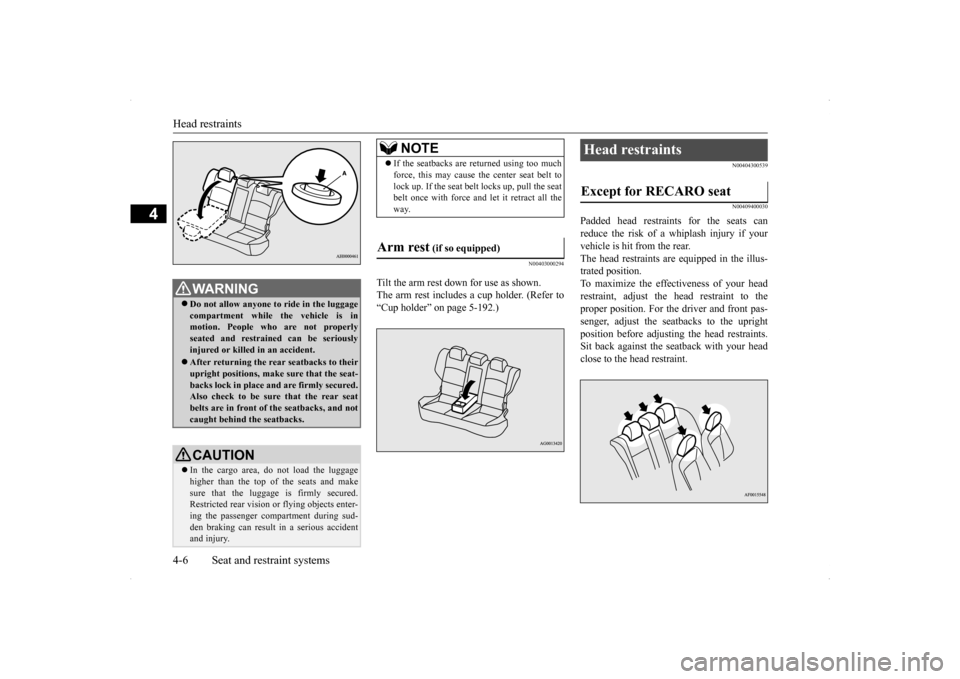
Head restraints 4-6 Seat and restraint systems
4
N00403000294
Tilt the arm rest down for use as shown. The arm rest includes a cup holder. (Refer to “Cup holder” on page 5-192.)
N00404300539 N00409400030
Padded head restraints for the seats can reduce the risk of a whiplash injury if yourvehicle is hit from the rear. The head restraints are equipped in the illus- trated position.To maximize the effectiveness of your headrestraint, adjust the head restraint to the proper position. For the driver and front pas- senger, adjust the seatbacks to the uprightposition before adjusting the head restraints. Sit back against the seatback with your head close to the head restraint.
WA R N I N G Do not allow anyone to ride in the luggage compartment while the vehicle is in motion. People who are not properlyseated and restrained can be seriously injured or killed in an accident. After returning the rear seatbacks to their upright positions, make sure that the seat- backs lock in place and are firmly secured.Also check to be sure that the rear seat belts are in front of the seatbacks, and not caught behind the seatbacks.CAUTION In the cargo area, do not load the luggage higher than the top of the seats and make sure that the luggage is firmly secured.Restricted rear vision or flying objects enter- ing the passenger compartment during sud- den braking can result in a serious accidentand injury.
NOTE
If the seatbacks are returned using too much force, this may cause the center seat belt to lock up. If the seat belt locks up, pull the seat belt once with force and let it retract all the way.
Arm rest
(if so equipped)
Head restraints Except for RECARO seat
Page 39 of 434
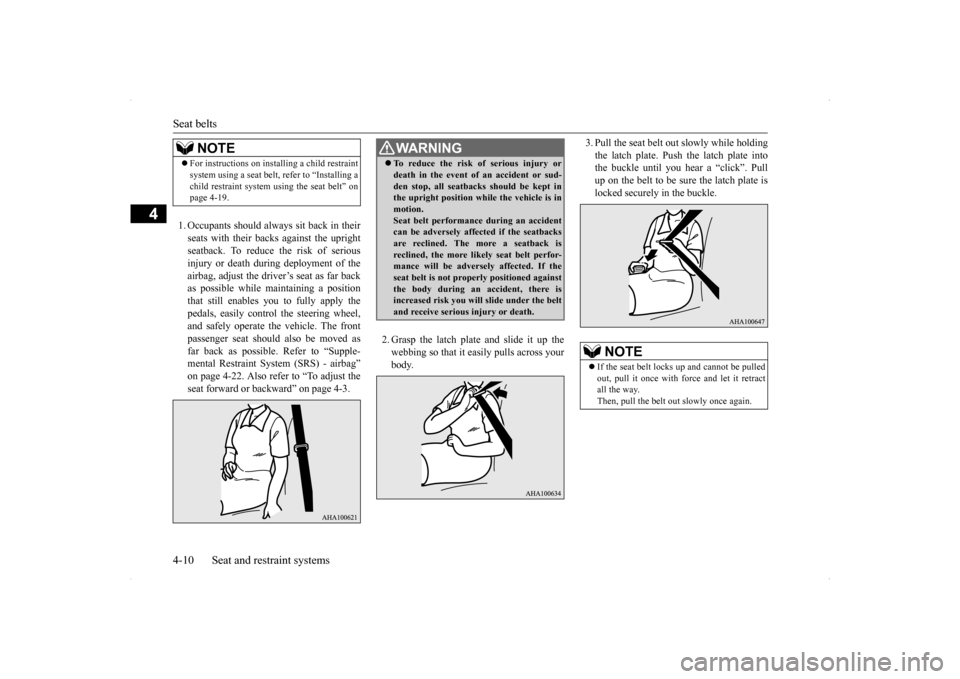
Seat belts 4-10 Seat and restraint systems
4
1. Occupants should always sit back in their seats with their backs against the upright seatback. To reduce the risk of seriousinjury or death during deployment of theairbag, adjust the driver’s seat as far back as possible while maintaining a position that still enables you to fully apply thepedals, easily control the steering wheel, and safely operate the vehicle. The front passenger seat should also be moved asfar back as possible. Refer to “Supple- mental Restraint System (SRS) - airbag” on page 4-22. Also refer to “To adjust theseat forward or backward” on page 4-3.
2. Grasp the latch plate and slide it up the webbing so that it easily pulls across yourbody.
3. Pull the seat belt out slowly while holding the latch plate. Push the latch plate into the buckle until you hear a “click”. Pull up on the belt to be sure the latch plate islocked securely in the buckle.
NOTE
For instructions on installing a child restraint system using a seat belt, refer to “Installing a child restraint system using the seat belt” on page 4-19.
WA R N I N G To reduce the risk of serious injury or death in the event of an accident or sud- den stop, all seatbacks should be kept in the upright position while the vehicle is in motion.Seat belt performance during an accident can be adversely affected if the seatbacks are reclined. The more a seatback isreclined, the more likely seat belt perfor- mance will be adversely affected. If the seat belt is not properly positioned againstthe body during an accident, there is increased risk you will slide under the belt and receive serious injury or death.
NOTE
If the seat belt locks up and cannot be pulled out, pull it once with force and let it retractall the way. Then, pull the belt out slowly once again.
Page 41 of 434
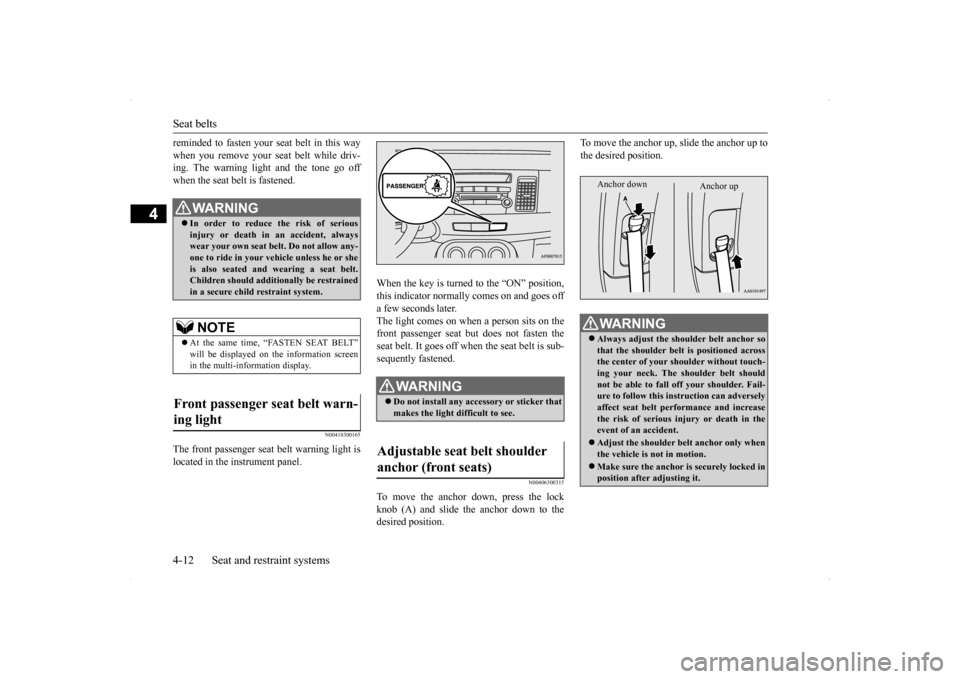
Seat belts 4-12 Seat and restraint systems
4
reminded to fasten your seat belt in this way when you remove your seat belt while driv- ing. The warning light and the tone go off when the seat belt is fastened.
N00418300165
The front passenger seat belt warning light islocated in the instrument panel.
When the key is turned to the “ON” position, this indicator normally comes on and goes offa few seconds later. The light comes on when a person sits on the front passenger seat but does not fasten theseat belt. It goes off when the seat belt is sub- sequently fastened.
N00406300315
To move the anchor
down, press the lock
knob (A) and slide the anchor down to the desired position.
To move the anchor up, slide the anchor up to the desired position.
WA R N I N G In order to reduce the risk of serious injury or death in an accident, alwayswear your own seat belt. Do not allow any- one to ride in your vehicle unless he or she is also seated and wearing a seat belt.Children should additionally be restrained in a secure child restraint system.NOTE
At the same time, “FASTEN SEAT BELT” will be displayed on the information screen in the multi-information display.
Front passenger seat belt warn- ing light
WA R N I N G Do not install any accessory or sticker that makes the light difficult to see.
Adjustable seat belt shoulder anchor (front seats)
WA R N I N G Always adjust the shoulder belt anchor so that the shoulder belt is positioned acrossthe center of your shoulder without touch- ing your neck. The shoulder belt should not be able to fall off your shoulder. Fail-ure to follow this instruction can adversely affect seat belt performance and increase the risk of serious injury or death in theevent of an accident. Adjust the shoulder belt anchor only when the vehicle is not in motion. Make sure the anchor is securely locked in position after adjusting it.Anchor down
Anchor up
Page 45 of 434
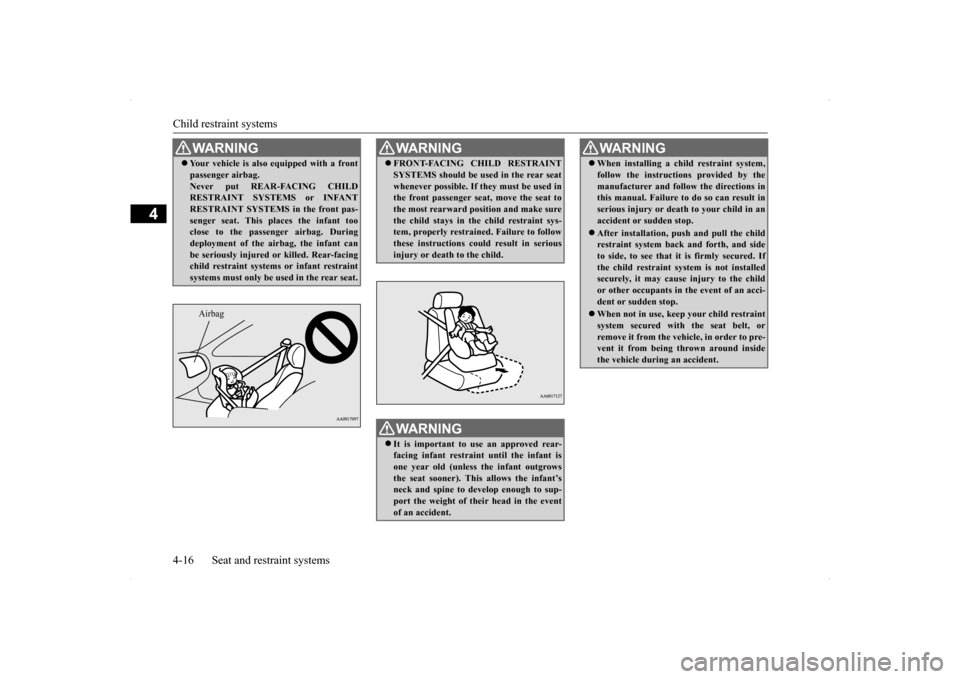
Child restraint systems 4-16 Seat and restraint systems
4
WA R N I N G Your vehicle is also equipped with a front passenger airbag. Never put REAR-FACING CHILD RESTRAINT SYSTEMS or INFANT RESTRAINT SYSTEMS in the front pas-senger seat. This places the infant too close to the passenger airbag. During deployment of the airbag, the infant canbe seriously injured or killed. Rear-facing child restraint systems or infant restraint systems must only be used in the rear seat.Airbag
WA R N I N G FRONT-FACING CHILD RESTRAINT SYSTEMS should be used in the rear seat whenever possible. If they must be used in the front passenger seat, move the seat to the most rearward position and make surethe child stays in the child restraint sys- tem, properly restrained. Failure to follow these instructions could result in seriousinjury or death to the child.WA R N I N G It is important to use an approved rear- facing infant restraint until the infant isone year old (unless the infant outgrows the seat sooner). This allows the infant’s neck and spine to develop enough to sup-port the weight of their head in the event of an accident.
When installing a child restraint system, follow the instructions provided by the manufacturer and follow the directions in this manual. Failure to do so can result in serious injury or death to your child in anaccident or sudden stop. After installation, push and pull the child restraint system back
and forth, and side
to side, to see that it is firmly secured. If the child restraint system is not installedsecurely, it may cause injury to the child or other occupants in the event of an acci- dent or sudden stop. When not in use, keep your child restraint system secured with the seat belt, orremove it from the vehicle, in order to pre- vent it from being thrown around inside the vehicle during an accident. WA R N I N G